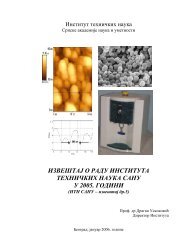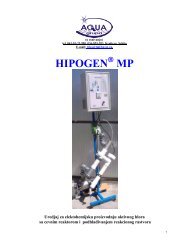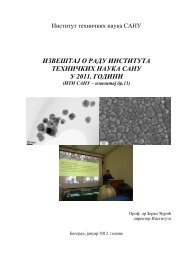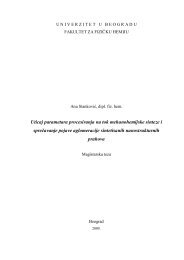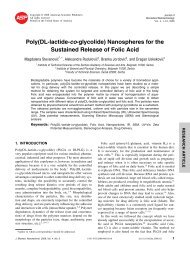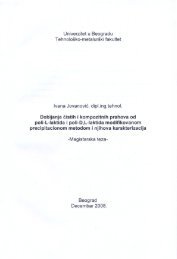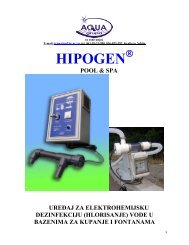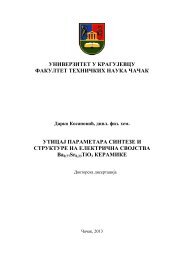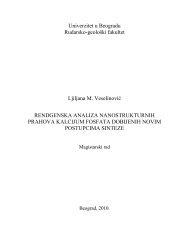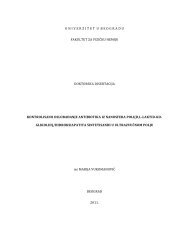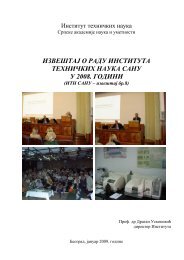Program and the Book of Abstracts (PDF) - Mrs-serbia.org.rs
Program and the Book of Abstracts (PDF) - Mrs-serbia.org.rs
Program and the Book of Abstracts (PDF) - Mrs-serbia.org.rs
You also want an ePaper? Increase the reach of your titles
YUMPU automatically turns print PDFs into web optimized ePapers that Google loves.
Tenth Young Researche<strong>rs</strong> Conference – Materials Science <strong>and</strong> Engineering<br />
December 21-23, 2011, Hall 2, SASA, Knez Mihailova 35 & 36, Belgrade, Serbia<br />
I/3<br />
One – pot syn<strong>the</strong>sis <strong>of</strong> hydrophobic hydroxyapatite nano particles<br />
Zoran Stojanović, Miodrag Lukić, Dragan Uskoković<br />
Institute <strong>of</strong> Technical Sciences <strong>of</strong> SASA, Belgrade, Serbia<br />
A highly hydrophobic oleic acid functionalized hydroxyapatite nanoparticles were obtained by<br />
<strong>the</strong> solvo<strong>the</strong>rmal method. Water solutions <strong>of</strong> reactants were added in mixture <strong>of</strong> oleic acid,<br />
triethanolamine <strong>and</strong> ethanol, which was <strong>the</strong>n treated in Teflon lined autoclave. The chemical<br />
composition, size <strong>and</strong> morphology <strong>of</strong> as obtained particles were determined using XRD, FT IR, FE<br />
SEM <strong>and</strong> LD PSA. In addition, sintering behaviour <strong>and</strong> microstructure <strong>of</strong> prepared material were<br />
also examined.<br />
I/4<br />
Syn<strong>the</strong>sis <strong>and</strong> <strong>the</strong> effect <strong>of</strong> processing paramete<strong>rs</strong> on characteristics<br />
<strong>of</strong> poly-ε-caprolactone micro- <strong>and</strong> nanospheres<br />
Nenad Filipović 1 , Magdalena Stevanović 1 , Vladimir Pavlović 1, 2 ,<br />
Aleks<strong>and</strong>ra Radulović 3 , Zoran Stojanović 1 , Dragan Uskoković 1<br />
1 Institute <strong>of</strong> Technical Sciences <strong>of</strong> SASA, Belgrade, Serbia, 2 Faculty <strong>of</strong> Agriculture, Unive<strong>rs</strong>ity <strong>of</strong><br />
Belgrade, Belgrade, Serbia, 3 Institute <strong>of</strong> General <strong>and</strong> Physical Chemistry, Belgrade, Serbia<br />
Poly-ε-caprolactone (PCL) is a semicrystalline, biodegradable <strong>and</strong> biocompatible polymer. Its<br />
advantages, as high permeability to small drug molecules, failure to generate an acidic environment<br />
during degradation (as compared to polylactides <strong>and</strong> polyglycolides) <strong>and</strong> a slow degradation rate,<br />
make this aliphatic polyester suitable for extended long-term delivery over a period <strong>of</strong> more than<br />
one year. In this study PCL particles were prepared by physicochemical method with solvent/nonsolvent<br />
systems. The syn<strong>the</strong>tic polymer polyvinylpyrrolidone (PVP) <strong>and</strong> natural polymer poly (α, γ,<br />
L-glutamic acid) (PGA), were used as stabilize<strong>rs</strong> <strong>and</strong> <strong>the</strong>ir influence on size <strong>and</strong> morphology <strong>of</strong> <strong>the</strong><br />
particles was examined. The results were compared with those obtained without <strong>the</strong> use <strong>of</strong><br />
stabilize<strong>rs</strong>. Characterization <strong>of</strong> obtained particles was performed by Fourier transform infrared<br />
spectroscopy. The morphology <strong>and</strong> size distribution were determined using SEM <strong>and</strong> particle<br />
analyzer.<br />
2





